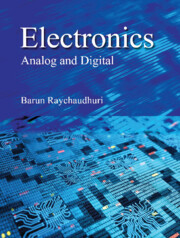Book contents
Summary
The previous chapter has dealt with digital circuits having output states dependent only on the instantaneous combination of the inputs. There exist yet another set of digital circuits, known as sequential logic circuits, which are presented in this chapter. A sequential digital circuit is almost always associated with a clock or a timer. This chapter illustrates the properties of a clock and explains several popular sequential digital circuits, namely flip-flop, register and counter that are the building blocks for many complicated digital systems including computer hardware.
Clock and Timer
First let us understand the meaning of the word ‘sequential’ sticking to some digital circuits. It is named so because:
• the output is affected by the positional and temporal sequence of the input states,
• the sequence of the change of output states is different from that of the inputs, and
• a memory property is sometimes exhibited by holding one or more bits in terms of voltage levels.
Table 14.1 may be revisited in this occasion. Now the question arises, who makes this sequence to occur? That is the job of the clock and the timer. As explained in the previous chapters, digital circuits need two fixed and discrete voltage states as inputs. It is a very common phenomenon in a digital system, such as a computer that a number of circuits have to change the logic states in synchronism. That synchronizing is initiated by a timer and a clock.
The timer is an electronic circuit that generates a voltage waveform, generally square or rectangular, of well-defined amplitude and precise frequency. That voltage waveform of fixed amplitude and frequency generated by the timer is referred to as clock signal, clock pulse or simply clock. It defines a timing interval during which the circuit operations must be performed. Thus the timer is the ‘heart’ and the clock is the ‘heartbeat’ of a digital system. The clock has the following properties.
• It may be symmetric or asymmetric voltage waveform but should have fixed and pre-determined amplitude and frequency.
• The prime requirement for a clock is the perfection of its frequency and its stability.
• The high and low voltage levels of the clock should be distinct enough for denoting logical 1 and 0.
The absolute voltage values should comply with the circuit requirements.
- Type
- Chapter
- Information
- Electronics , pp. 557 - 608Publisher: Cambridge University PressPrint publication year: 2023

